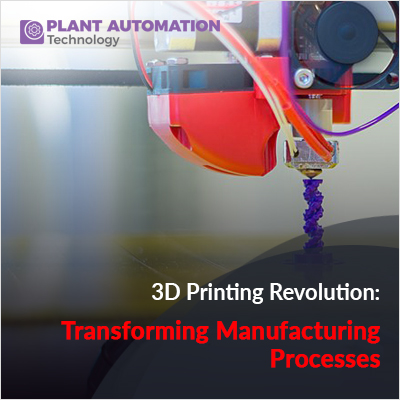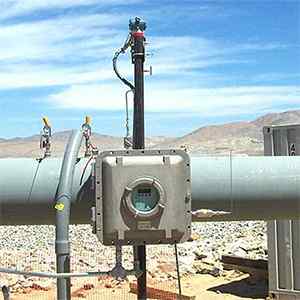3D Printing Revolution: Transforming Manufacturing Processes

Introduction:
In the manufacturing industry, 3D printing has emerged as a transformative and disruptive force in recent years, challenging conventional methods and ushering in a new era of possibilities. Also referred to as additive manufacturing, this revolutionary technology entails the layer-by-layer construction of three-dimensional objects based on digital models. This article explores the significant influence of 3D printing on traditional manufacturing procedures, its wide-ranging applications in various industries, and its potential to fundamentally reshape supply chains.
I. Evolution of 3D Printing: From Prototyping to Production
1. Origins of 3D Printing:
The inception of 3D printing dates back to the early 1980s, with credit attributed to Dr. Hideo Kodama's contributions in Japan and Charles Hull's invention of stereolithography in the United States. These initial advancements established the groundwork for a technology that would later undergo transformative developments.
2. Rapid Prototyping Emergence:
During the late 1980s and early 1990s, 3D printing gained popularity as a method for rapid prototyping, particularly in industries like aerospace and automotive. Companies widely adopted this technology to accelerate the product development cycle, aiming to streamline the process and diminish the time and expenses traditionally associated with prototyping methods.
| Also Read: Advanced Materials in Industrial Manufacturing: Innovations and Applications |
3. Stereolithography and Selective Laser Sintering:
Stereolithography (SLA) and Selective Laser Sintering (SLS) emerged as the pioneering 3D printing technologies during this period. SLA utilized photopolymerization, while SLS employed laser sintering of powdered materials, expanding the possibilities for creating complex geometries.
4. Transition to End-Use Parts:
By the mid-1990s, 3D printing technologies evolved beyond prototyping and began to be explored for creating end-use parts. This marked a significant shift in perception, as manufacturers started recognizing the potential of 3D printing for producing functional components rather than just prototypes.
5. Advancements in Material Science:
One of the key factors enabling the transition to production was the development of a wider range of materials suitable for 3D printing. Innovations in polymer chemistry, metals, ceramics, and composite materials expanded the applications of 3D printing across diverse industries.
6. Industrial Adoption in the 2000s:
The 2000s witnessed increased industrial adoption of 3D printing technologies. Companies began integrating these technologies into their production processes for creating tooling, jigs, fixtures, and even limited runs of end-use parts.
7. Move to Additive Manufacturing:
The terminology shifted from "3D printing" to "additive manufacturing" (AM) to better reflect the technology's broader applications. Additive manufacturing encompassed not only layer-by-layer printing but also other additive processes like powder bed fusion, material extrusion, and directed energy deposition.
8. Rise of Metal 3D Printing:
The 2010s saw a surge in interest and investment in metal 3D printing. This development opened up new possibilities for industries requiring strong and lightweight metal components, such as aerospace, healthcare, and automotive.
9. Mainstream Adoption and Industry 4.0:
In recent years, 3D printing has become more accessible and integrated into mainstream manufacturing. The concept of Industry 4.0, with its emphasis on smart factories and digitalization, has further propelled the adoption of 3D printing for on-demand production and agile manufacturing.
10. Current Landscape and Future Prospects:
Today, 3D printing is a versatile technology used across various industries, including healthcare, aerospace, automotive, and consumer goods. Ongoing research focuses on improving speed, scale, and material options, paving the way for an exciting future where 3D printing plays a central role in the manufacturing landscape.
II. Applications across Industries: A Multifaceted Revolution
1. Aerospace Advancements:
- Lightweight Components: 3D printing has revolutionized aerospace by enabling the production of lightweight components critical for fuel efficiency. Examples include intricately designed and optimized aircraft parts, such as brackets, interiors, and even structural components that are both strong and lightweight.
- Complex Engine Parts: In the aerospace industry, 3D printing is used to manufacture intricate engine components with advanced geometries that enhance performance. This includes components like turbine blades and fuel nozzles, showcasing the technology's capability to produce parts with complex internal structures.
2. Healthcare Innovations:
- Customized Medical Implants: 3D printing has transformed the healthcare sector by allowing the production of customized implants tailored to a patient's unique anatomy. Examples include patient-specific orthopedic implants, dental implants, and cranial implants, improving patient outcomes and reducing the need for standard-sized implants.
- Bioprinting: Beyond traditional 3D printing, the technology is making strides in bioprinting for creating living tissues and organs. Researchers are exploring the potential to print functional organs, such as kidneys and hearts, using a patient's own cells.
3. Automotive Revolution:
- Prototyping and Concept Cars: Automotive manufacturers leverage 3D printing for rapid prototyping and the development of concept cars. This allows for quicker design iterations and the testing of new features, streamlining the product development cycle.
- Customized Automotive Parts: 3D printing enables the production of customized and on-demand automotive parts. This includes components like interior trim, brackets, and even lightweight structural elements that contribute to fuel efficiency.
4. Consumer Goods Customization:
- Personalized Products: 3D printing has opened up opportunities for the customization of consumer goods. From personalized smartphone cases to custom-designed furniture, consumers can now enjoy products tailored to their preferences, contributing to a more personalized and sustainable consumer experience.
- Fashion and Wearables: The fashion industry has embraced 3D printing for creating avant-garde designs and unique wearables. Designers use the technology to produce intricate jewelry, footwear, and even clothing items with complex geometries.
5. Industrial Manufacturing Applications:
- Tooling and Jigs: 3D printing is widely used in industrial manufacturing for producing tooling, jigs, and fixtures. Manufacturers can quickly design and produce these components in-house, reducing lead times and costs associated with traditional machining.
- Prototyping for Mass Production: Industries such as electronics and consumer goods use 3D printing to prototype and test designs before mass production. This helps identify and address issues early in the product development process, saving time and resources.
6. Architectural and Construction Uses:
- Architectural Models: Architects and urban planners use 3D printing to create detailed architectural models. This allows for better visualization of projects and enhances communication with stakeholders.
- Custom Building Components: Within the construction sector, 3D printing is utilized for the creation of personalized building components, including facades and structural elements. This application has the potential to enhance construction efficiency and minimize waste.
The versatility and transformative capabilities of 3D printing are evident in its applications across various industries. Whether in healthcare, aerospace, or beyond, 3D printing is not merely revolutionizing manufacturing processes but is also opening up new avenues for customization, efficiency, and innovation across different sectors. As technological advancements progress, the reach and influence of 3D printing are poised to extend even more, playing a pivotal role in shaping the future of manufacturing across a wide array of industries.
III. Advantages of 3D Printing Over Traditional Manufacturing:
a. Design Flexibility: Unlocking Intricate and Complex Designs
One of the primary advantages of 3D printing lies in its unparalleled design flexibility. Unlike traditional manufacturing methods that often impose limitations on geometric complexity, 3D printing allows for the creation of intricate and highly complex designs. This is achieved through layer-by-layer additive processes, enabling the production of shapes and structures that would be challenging or impossible to achieve with subtractive methods.
- Geometric Freedom: 3D printing liberates designers from the constraints of traditional machining, empowering them to explore intricate geometries, organic shapes, and complex internal structures. This capability is particularly beneficial in industries such as aerospace and healthcare, where lightweight and intricately designed components are crucial for optimal performance.
- Complex Internal Features: Traditional manufacturing processes may struggle with the fabrication of intricate internal features within a component. With 3D printing, however, designers can create objects with complex internal channels, lattices, and voids, enhancing both functionality and efficiency.
- Customization and Personalization: The design flexibility of 3D printing extends to customization. Products can be tailored to individual preferences and requirements, offering a level of personalization that is challenging to achieve with mass production methods.
b. Cost Efficiency: Reducing Waste, Tooling Costs, and Improving Efficiency
3D printing brings about several cost-efficiency advantages, transforming the economic landscape of manufacturing processes.
- Reduced Material Waste: Conventional manufacturing processes typically entail removing material from a larger block, leading to substantial waste. In contrast, 3D printing follows an additive approach, depositing material layer by layer. This minimizes waste and optimizes material usage, a particularly advantageous feature when dealing with materials that are expensive or in limited supply.
- Lower Tooling Costs: Traditional manufacturing frequently requires the production of molds, dies, or other tooling equipment, contributing to upfront costs. 3D printing eliminates or significantly reduces the need for such tooling, allowing for more cost-effective and agile production setups.
- Increased Production Efficiency: The layer-by-layer additive nature of 3D printing enables the simultaneous production of multiple components within a single build. This parallelization of production processes contributes to increased efficiency and shorter lead times compared to sequential manufacturing methods.
c. Rapid Prototyping and Iteration: Accelerating Product Development
3D printing's ability to facilitate rapid prototyping and iteration is a game-changer in the product development cycle.
- Quick Turnaround: Conventional prototyping methods, such as CNC machining or injection molding, are known for their time-consuming processes, resulting in extended development cycles. In contrast, 3D printing facilitates rapid prototyping, enabling designers to obtain physical prototypes within a matter of hours or days. This accelerates the overall product development timeline significantly.
- Cost-Effective Iteration: The ease of modifying digital designs and the quick turnaround of 3D printing make iterative design processes more cost-effective. Designers can test multiple iterations, make adjustments on the fly, and refine their prototypes without incurring significant additional costs.
- Enhanced Collaboration: The rapid prototyping capabilities of 3D printing facilitate better collaboration among interdisciplinary teams. Designers, engineers, and stakeholders can quickly visualize and interact with physical prototypes, fostering effective communication and reducing the risk of misinterpretation.
The merits of 3D printing in contrast to traditional manufacturing methods, embracing aspects like design flexibility, cost-effectiveness, and swift prototyping, establish this technology as a revolutionary factor across diverse industries. As 3D printing progresses, overcoming challenges and evolving, its influence on product innovation, customization, and production efficiency is poised to grow more significant in the foreseeable future.
IV. Reshaping Supply Chains:
a. On-Demand Manufacturing: Eliminating Large Inventories and Enhancing Responsiveness
The arrival of 3D printing has initiated a fundamental shift in manufacturing, especially concerning the notion of on-demand manufacturing.
- Just-in-Time Production: Traditional manufacturing often relies on mass production and the maintenance of large inventories. With 3D printing, companies can adopt a just-in-time production model, where items are manufactured only when needed. This reduces the costs associated with holding excess inventory and minimizes the risks of overproduction.
- Reduced Storage Costs: On-demand manufacturing significantly diminishes the need for extensive warehouse space to store finished goods. Companies can save on storage costs and better allocate resources to other areas of their operations.
- Customization Without Overhead: On-demand 3D printing enables customization without the necessity of managing an extensive inventory of pre-made products. This approach allows products to be adjusted to specific customer requirements, delivering a more personalized experience without the requirement for pre-manufactured variations.
b. Localized Production: Decentralizing Manufacturing for Increased Agility
The geographical decentralization of manufacturing is a key benefit that 3D printing brings to the table.
- Reducing Dependence on Global Supply Chains: Traditional manufacturing often involves complex and lengthy global supply chains. By decentralizing production through 3D printing, companies can reduce their dependence on these intricate networks, minimizing the impact of geopolitical events, transportation disruptions, and other external factors.
- Enabling Regional Hubs: 3D printing facilitates the creation of regional manufacturing hubs. These hubs can cater to the specific needs of local markets, fostering economic growth, reducing transportation costs, and contributing to the development of more sustainable business practices.
- Quick Response to Market Changes: Localized 3D printing capabilities empower companies to respond rapidly to shifts in consumer demand, market trends, or unforeseen events. This agility enhances a company's ability to adapt to changing circumstances and capitalize on emerging opportunities.
c. Customization and Personalization: Tailoring Products to Individual Need
One of the most impactful aspects of 3D printing in reshaping supply chains is its ability to facilitate mass customization.
- Individualized Production Runs: Traditional manufacturing struggles to accommodate individualized product requirements due to the constraints of mass production processes. 3D printing allows for the cost-effective production of small batches or even individual items, meeting the unique preferences and needs of customers.
- Personalized Design Options: Consumers can actively participate in the design process, customizing products according to their preferences. This not only enhances the customer experience but also creates a deeper connection between the consumer and the product.
- Evolving Business Models: The shift toward customization and personalization has prompted companies to explore new business models. Direct-to-consumer (DTC) strategies and online platforms allow customers to design and order personalized products, providing a competitive edge in today's market.
The transformation of supply chains through on-demand manufacturing, localized production, and mass customization with 3D printing represents a profound change in how goods are manufactured and delivered. With ongoing technological advancements, there is the potential for this technology to revolutionize the traditional supply chain model, creating a more responsive, sustainable, and tailored system to meet the dynamic demands of the modern marketplace.
V. Challenges and Future Outlook:
Despite the significant advancements in 3D printing technology, challenges and limitations related to materials persist.
- Limited Material Options: Traditional manufacturing processes offer a wide range of materials, but 3D printing is often limited to specific materials suitable for each printing technology. Researchers are actively working on expanding the range of printable materials, including metals, ceramics, and polymers, to meet diverse industry needs.
- Material Strength and Durability: Achieving the required strength and durability in 3D-printed parts can be challenging, especially in industries with stringent performance standards such as aerospace and automotive. Ongoing research focuses on developing composite materials and optimizing printing parameters to enhance mechanical properties.
- Biocompatible Materials: In the realm of medical applications, there is a growing need for biocompatible materials suitable for 3D printing implants and prosthetics. Researchers are exploring materials that are not only compatible with the human body but also exhibit the necessary mechanical properties.
b. Scale-Up Challenges: Navigating Hurdles in Large-Scale 3D Printing
As 3D printing gains popularity, the challenge of scaling up production for large-scale manufacturing becomes more apparent.
- Speed and Throughput: Large-scale production requires increased speed and throughput. Traditional 3D printing methods can be time-consuming, hindering their efficiency in high-volume manufacturing. Ongoing research aims to enhance printing speed and develop innovative approaches such as continuous 3D printing.
- Quality Control in Mass Production: Maintaining consistent quality in large-scale 3D printing presents challenges in terms of precision and repeatability. Implementing advanced monitoring systems and quality control measures is essential to ensure that each printed item meets the required standards.
- Cost Efficiency: Large-scale 3D printing may face cost challenges, including the cost of materials, equipment, and energy consumption. Researchers are exploring cost-effective solutions, such as novel printing technologies, optimized workflows, and sustainable materials.
c. Emerging Technologies: The Future Landscape of 3D Printing
The future of 3D printing holds exciting possibilities, driven by emerging technologies that push the boundaries of what is currently achievable.
- Multi-Material Printing: Advancements in multi-material 3D printing enable the creation of complex, heterogeneous structures with diverse properties. This technology has applications in electronics, where circuits can be integrated directly into 3D-printed objects.
- Bioprinting: The field of bioprinting is making significant strides, with researchers working on printing living tissues and organs. This technology has immense potential in medicine, offering the possibility of creating custom-designed implants and facilitating organ transplantation.
- Artificial Intelligence Integration: The infusion of artificial intelligence (AI) into 3D printing procedures is augmenting design optimization, error detection, and production efficiency. Real-time data analysis by AI algorithms contributes to enhanced print quality and diminished material waste.
While 3D printing has transformed manufacturing, challenges persist, and ongoing research and development efforts are dedicated to overcoming these obstacles. The future of 3D printing looks promising, with advancements in materials, large-scale production capabilities, and the integration of emerging technologies poised to unlock new possibilities and drive innovation across industries.
Conclusion:
As 3D printing continues to evolve and gain traction, its impact on manufacturing processes becomes increasingly evident. From transforming the way products are designed and produced to reshaping entire supply chain dynamics, the 3D printing revolution is poised to leave an indelible mark on the future of manufacturing. Embracing this technology presents opportunities for innovation, sustainability, and a more agile approach to meeting the demands of a rapidly changing market.











